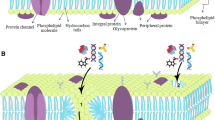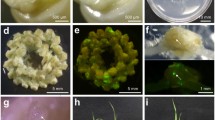Summary
Gene transfer into intact cells was achieved by electroporating zygotic wheat embryos without any special pretreatment. Electroporation was tissue specific in so far as scutellum cells were found to be much more susceptible to gene transfer than other cell types of the embryo. The orientation of the embryos in the electroporation chamber also influenced the number of transformed scutellum cells; during electroporation, as in electrophoresis, the negatively charged plasmid DNA molecules seemed to move towards the positive electrode. Therefore, the embryos were arranged so that the scutella faced the negative electrode. The use of plasmids carrying either two chimeric anthocyanin regulatory genes or a chimeric gusA gene allowed clear identification of transformed cells in the scutellum. On some of the embryos, more than 100 transformed scutellum cells were found after electroporation with single electric pulses of 275 V/cm discharged from a 960-μF capacitor and with 100 μg DNA/ml electroporation buffer. Using the anthocyanin marker system, visibly transformed cells grew to produce red sectors.
Similar content being viewed by others
Abbreviations
- 2,4-D:
-
2,4-dichlorophenoxyacetic acid
- GUS:
-
β-glucuronidase
- MES:
-
2-N-morpholinoethane sulfonic acid
References
Christou P, Ford TL, Kofron M (1991) Bio/Technology 9: 957–962.
Christou P (1992) The Plant J. 2(3): 275–281.
Cone KC, Burr FA, Burr B (1986) Proc. Natl. Acad. Sci. USA 83: 9631–9635.
Datta SK, Peterhans A, Datta K, Potrykus I (1990) Bio/Technology 8: 736–740.
Datta SK, Datta K, Soltanifar N, Donn G, Potrykus I (1992) Plant Mol. Biol. 20: 619–629.
Dekeyser RA, Claes B, De Rycke RMU, Habets ME, Van Montagu MC, Caplan AB (1990). Plant Cell 2: 591–602.
Dimitrov DS, Sowers AE (1990) Biochim. Biophys. Acta. 1022: 381–392.
Donn G, Nilges M, Morocz S (1990) Abstract, 7th Int. Congress on Plant Tissue and Cell Culture, A2: 38–53.
D'Halluin K, Bonne E, Bossut M, De Beuckeleer M, Leemans J (1992) Plant Cell 4: 1495–1505.
Fromm ME, Fionnuala M, Armstrong C, Rosalind W, Thomas J, Klein TM (1990) Bio/Technology 8: 833–839.
Goff SA, Klein TM, Roth BA, Fromm ME, Cone KC, Radicella JP, Chandler VL (1990) EMBO J. 9: 2517–2522.
Gordon-Kamm WJ, Lemaux PG (1992) Plant Mol. Biol. 18: 201–210.
Hayashimoto A, Li Z, Murai N (1990) Plant Physiol 93: 857–863.
He DG, Tanner G, Scott KJ (1986) Plant Sci. 45: 119–124.
Hodal L, Bochardt A, Nielsen JE, Mattsson O, Okkels FT (1992) Plant Science 87: 115–122.
Jefferson RA, Kavanagh TA, Bevan MW (1987) EMBO J. 6: 3901–3907.
Klein TM, Arentzen R, Lewis PA, Fitzpatrick-McElligott S (1992) Bio/Technology 10: 286–291.
Klenchin VA, Sukharev SI, Serov SM, Chemomordik LV, Chizmadzhev YuA (1991) Biophys. J. 60: 804–811.
Lindsey K, Jones MGK (1987) Plant Mol.Biol. 10: 43–52.
McElroy D, Zhang W, Wu R (1990) Plant Cell 2: 163–171.
Mendel RR, Müller B, Schulze J, Kolesnikov V, Zelenin A (1989) Theor. Appl. Genet. 78: 31–34.
Morikawa H, Iida A, Matsui C, Ikegami M, Yamada Y (1986) Gene 41: 121–124.
Murashige T, Skoog F (1962) Physiol. Plant. 15: 473–497.
Neumann E, Schaefer-Ridder M, Wang Y, Hofschneider PH (1982) EMBO J. 1: 841–845.
Shimamoto K, Terada R, Izaawa T, Fujimoto H (1989) Nature 337: 274–276.
Songstad DD, Halaka FG, DeBoer DL, Armstrong CL, Hinchee MAW, Ford-Santino CG, Brown SM, Fromm ME, Horsch RB (1993) Pl. Cell Tis. Organ Culture 33: 195–201.
Tada Y, Sakamoto M, Fujimura T (1990) Theor. Appl. Genet. 80: 475–480.
Vasil V, Redway F, Vasil IK (1990) Bio/Technology 8: 429–433.
Vasil V, Castillo AM, Fromm ME, Vasil IK (1992) Bio/Technology 10: 667–674.
Walters DA, Vetsch CS, Potts DE, Lundquist RC (1992) Plant Mol. Biol. 18: 189–200.
Xie TD, Sun L, Zhao HG, Fuchs JA, Tsong TY (1992) Biophys. J. 63: 1026–1031.
Author information
Authors and Affiliations
Additional information
Communicated by H. Lörz
Rights and permissions
About this article
Cite this article
Klöti, A., Iglesias, V.A., Wünn, J. et al. Gene transfer by electroporation into intact scutellum cells of wheat embryos. Plant Cell Reports 12, 671–675 (1993). https://doi.org/10.1007/BF00233417
Received:
Revised:
Issue Date:
DOI: https://doi.org/10.1007/BF00233417




